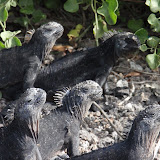 |
| Arrival and The Huddle Test |
After a last minute flurry of e-mails, planning, packing, and repacking, we were ready. The equipment had been shipped ahead. Five of the seven scientists met at the Darwin Research Center in the town of Puerto Ayora, Santa Cruz Island, Galapagos, Ecuador on Monday, July 20. There we tested the equipment in “The Huddle.” Next, we traveled together, with the equipment, overnight by ship to Puerto Villamil on the Island of Isabela. There, after meeting two Ecuadoran geoscientists, our scientific party was complete. From that point we split into two groups. The “ship crew” traveled by sea, landing by launch, setting up seismic stations around the perimeter of Isabela Island. The “volcano crew” trekked by foot, horseback and helicopter transporting the heavy, delicate equipment to station sites around and within Sierra Negra Volcano.
It sounds simple. The reality was science and adventure that required collaboration, teamwork and use of all of our scientific skills.
In order to effectively hit the ground running when we arrived at the Darwin Research Center we built an extra travel day into our schedule. Scientists for this project were arriving from Rochester, NY, Socorro, NM, San Francisco, CA, Moscow, ID via London, Miami, FL and Quito, Ecuador. Four of us spent a Sunday afternoon, along with hundreds of proud local families, strolling along the Maleçon de Simon Bolivar. The last leg of our journey involved a plane, bus, ferry and taxi. We had just enough time to change clothes and then we were in The Huddle. Eliana Arias-Dotson, geophysicist and data specialist from Iris Passcal, gave instructions for the process and then, whatever our individual level of experience, we got to work. Although in the field there are usually three or four people, everyone had to learn the process of setting up a seismic station. Sixteen complete stations had to be unpacked, assembled and left running overnight as a test. By 8:30 pm, amidst a sea of wires, everything was working. Next morning all of the stations had to be disassembled and repacked for the trip to the field. There were also specific supplies like plastic storage containers, trash bags and solar panel mounts that had to be purchased or constructed for the unique characteristics of work in the Galapagos. At 3:00 pm our luggage and all equipment went into quarantine. We had to ensure that we were not transporting invasive species to pristine Isla Isabela. Our stroll along Maleçon de Simon Bolivar seemed far in the past.
Afternoon, July 22, we recovered everything from quarantine, loaded it aboard a water taxi for transport to the Ship Pirata. Overnight, a heavily loaded Pirata transported us to Isla Isabela. We awoke at the site of our first station, GS01.
